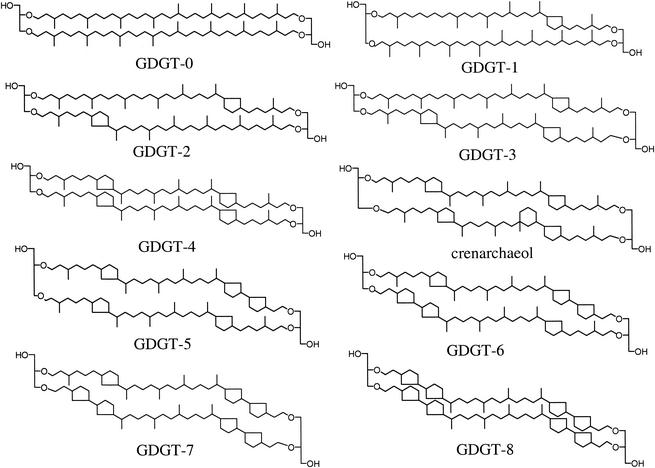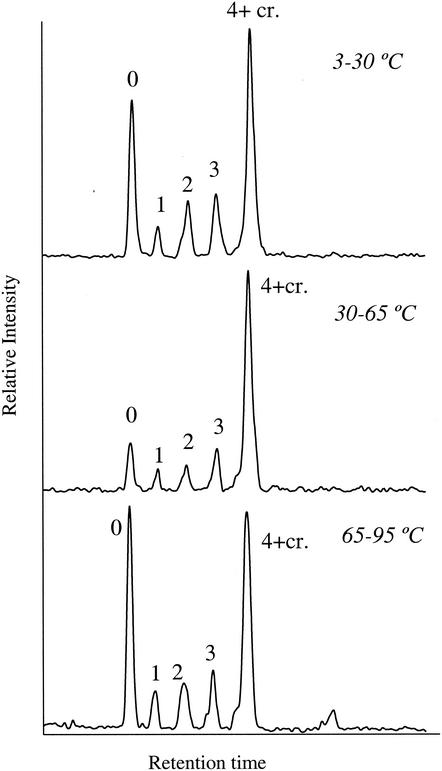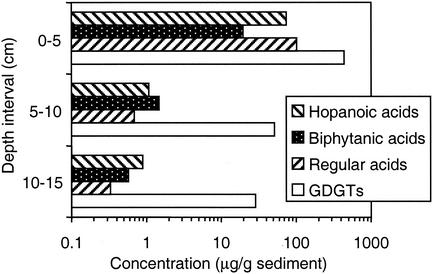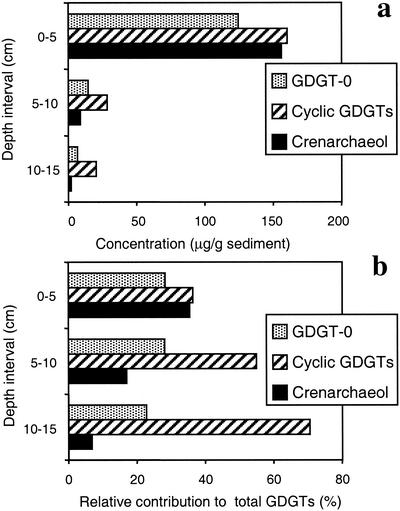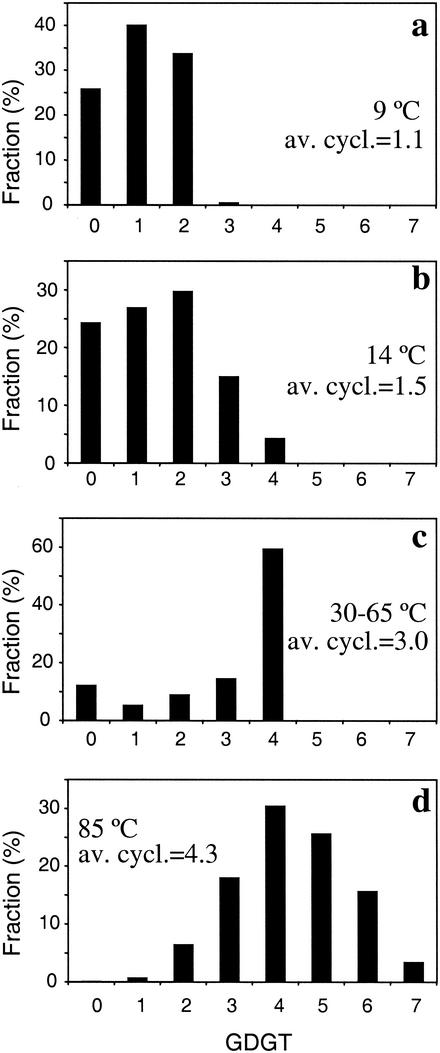Abstract
Distributions and isotopic analyses of lipids from sediment cores at a hydrothermally active site in the Guaymas Basin with a steep sedimentary temperature gradient revealed the presence of archaea that oxidize methane anaerobically. The presence of strongly 13C-depleted lipids at greater depths in the sediments suggests that microbes involved in anaerobic oxidation of methane are present and presumably active at environmental temperatures of >30°C, indicating that this process can occur not only at cold seeps but also at hydrothermal sites. The distribution of the membrane tetraether lipids of the methanotrophic archaea shows that these organisms have adapted their membrane composition to these high environmental temperatures.
The major present-day sink for methane generated in marine sediments is anaerobic oxidation of methane (AOM) (2, 17). This process has been known for several years, but the organisms responsible were not identified until a few years ago. Based on several lines of evidence, i.e., 13C-depleted biomarkers, specific gene sequences, and fluorescence in situ hybridization analysis, it is now clear that AOM involves methane-oxidizing archaea in a consortium (or consortia) with sulfate-reducing bacteria (1, 6, 8, 10, 14, 15, 16, 25, 26). These consortia are found at many sedimentary sites where methane is venting out into anoxic zones, including gas hydrates and cold methane seeps and in anoxic waters (21, 28).
Although the key microbial players in the AOM process have been identified, many aspects remain unknown. For example, it is unclear whether only a few specific consortia are responsible, as suggested by rRNA analysis (see, e.g., references 1 and 14), or whether a group of more diverse organisms is at work, as suggested by the heterogeneous biomarker distributions (see, e.g., reference 16). Furthermore, it is unclear under what environmental conditions these consortia function with respect to sulfide concentrations, methane fluxes, temperature, etc. Until now, nearly all studies of microorganisms involved in AOM have been carried out at oceanic sedimentary sites at relatively low environmental temperatures (0 to 15°C), such as gas hydrates and cold methane seeps (see, e.g., references 1, 6, 8, 15, and 26). Studies of hydrothermal vents where methane is seeping out at high temperatures (up to 300°C) have not been directed at microorganisms involved in the direct oxidation of methane. Recently, Teske et al. (25) reported the presence of 13C-depleted archaeal and bacterial biomarkers and characteristic gene sequences for methanotrophic archaea and sulfate-reducing bacteria in surface layers at several sites in the hydrothermal vent area of the Guaymas Basin. In this area, thermogenic methane seeps out at high rates (30). The results obtained by Teske et al. (25) clearly showed the presence of consortia of archaea and sulfate-reducing bacteria involved in the AOM in surface layers (0 to 1 cm deep) at ambient seawater temperatures (ca. 4 to 10°C), but these authors were unable to detect evidence of active microbial communities in deeper sediment layers.
Here we report the presence of 13C-depleted biomarker lipids of organisms involved in AOM in sediment layers up to 17 cm deep at a different hydrothermal vent site in the Guaymas Basin. The depth profiles of isotopic compositions and concentrations of biomarker lipids suggest that the consortia mediating AOM are active at temperatures well above 30°C.
MATERIALS AND METHODS
Samples.
The sediment cores were obtained during a cruise to the Guaymas Basin using the research submersible DSRV Alvin (Woods Hole Oceanographic Institution). The two investigated sediment cores (length, 35 cm; diameter, ca. 15 cm) were obtained (dive 3208, 1 May 1998) at the base of Rebecca’s Roost (27°00.679′N, 111°24.413′W) at a depth of 2,000 to 2,010 m. The sediments had some Beggiatoa mat on top. The temperatures measured in situ at our coring site rapidly increased with depth, i.e., 2.8°C at the surface, 30°C at 5 cm deep, 66°C at 10 cm deep, 95°C at 15 cm deep, 110°C at 20 cm deep, and 113°C at 25 cm deep. This temperature gradient is similar to what has been reported for related cores (29). Core 1 was sectioned into three parts (0 to 7.5, 7.5 to 12.5, and 12.5 to 17.5 cm) while core 2 was also sectioned into three parts but at different depths (0 to 5, 5 to 10, and 10 to 15 cm). The carbonate contents of the sediments, determined by measuring the weight difference between the sediment and the decalcified (by reaction with 1 N HCl for 18 h) sediment, varied between 23 and 37% (see Table 1). The total organic carbon contents and δ13C of total organic carbon, determined by elemental analysis (EA)-isotope-ratio-monitoring mass spectrometry (irmMS), varied from 1.4 to 3.3% and −21.7 to −25.7‰, respectively (see Table 1).
TABLE 1.
Bulk data of sediments analyzed from the Guaymas Basin cores
| Bulk property | Value for:
|
|||||
|---|---|---|---|---|---|---|
| Core 1 at depth (cm):
|
Core 2 at depth (cm):
|
|||||
| 0-7.5 | 7.5-12.5 | 12.5-17.5 | 0-5 | 5-10 | 10-15 | |
| Total organic carbon content (%) | 3.3 | 1.7 | 1.4 | 3.2 | 1.6 | 1.5 |
| Carbonate content (%) | 31 | 23 | 27 | 37 | 32 | 25 |
| δ 13C total organic carbon (in ‰ vs VPDB). | −25.7 | −24.7 | −21.8 | −24.5 | −24.9 | −21.7 |
Lipid extraction. The sediment samples were extracted with dichloromethane-methanol (2:1, vol/vol) and chromatographically separated on SiO2 (20 g, activated) into neutral lipids, glycolipids, and polar lipids using 200 ml of chloroform, acetone, and methanol, respectively. The neutral-lipid fractions were further fractionated on 5% deactivated SiO2 to obtain alcohol fractions. Polar lipids were saponified with 0.5 N KOH in methanol, and acids were extracted with hexane at pH <2. Alcohol fractions were derivatized using bistrimethylsilyltrifluoracetamide-pyridine, and acid fractions were methylated with BF3-methanol; both were then analyzed by gas chromatography (GC), GC-mass spectrometry (GC-MS) and irmGC-MS. For high-performance liquid chromotography (HPLC)-MS analysis of glycerol dibiphytanyl glycerol tetraethers (GDGTs) in the glycolipid fraction, the remaining solvent was removed under a stream of nitrogen and the residue was dissolved by sonication (10 min) in hexane-propanol (99:1, vol/vol). The resulting suspension was centrifuged (1 min at 2,300 × g), and the supernatant was filtered through a 0.45-μm-pore-size, 4-mm-diameter Teflon filter prior to injection. To analyze the isotopic composition of GDGT lipids, aliquots of glycolipid fractions were refluxed in 57% (by weight) HI (in H2O) for 4 h to cleave ether bonds (9). The alkyliodides formed were reduced to hydrocarbons with LiAlH4 in tetrahydrofuran (9). The hydrocarbons were analyzed by GC, GC-MS, and irmGC-MS.
Instrumental analysis.
EA-irmMS analyses were performed using a Carlo Erba Flash elemental analyzer coupled to a Thermofinnigan DeltaPLUS irmMS system. The total organic carbon content (as a percentage) was determined using external standards with know carbon content. Stable carbon isotope ratios were determined using lab standards calibrated on NBS-22 oil (IAEA) and reported in Vienna Pee Dee Belemnite (VPDB) notation. Biomarkers were analyzed and quantified on a Carlo Erba Fractovap 4160 gas chromatograph using a DB-5 column (0.25-mm inner diameter; 0.15-μm film thickness). Compounds were identified on an HP 5890 II gas chromatograph coupled to a Finnigan Incos 50 mass spectrometer and were isotopically analyzed using a Finnigan DeltaPLUS XL irmGC-MS system under similar chromatographic conditions. Isotopic values reported are averages of at least two analyses. Finally, intact GDGTs were identified by HPLC-atmospheric pressure positive-ion chemical ionization MS using conditions described previously (11). GDGTs were quantified by integration of peaks in summed mass chromatograms of [M + H]+ and [M + H]+ + 1 ions and compared with a standard curve obtained using a GDGT standard.
RESULTS AND DISCUSSION
Distribution and isotopic composition of lipids.
The biomarkers present in the various fractions of the solvent extracts from the two adjacent sediment cores from the Guaymas Basin are dominated by archaeal and bacterial lipids. GC-MS analysis of the alcohol fractions revealed that the surface layers of both cores are dominated by diplopterol and, to a lesser degree, tetrahymanol with only minute amounts of archaeol, a typical membrane lipid of nonthermophilic Euryarchaeota, and hydroxyarchaeol, a membrane lipid specific for methanogenic archaea (13). The last two components are, however, also associated with methanotrophic archaea (see e.g., references 8 and 15). Deeper sediment layers contained few GC-amenable compounds, i.e., small amounts of tetrahymanol and diplopterol, and consisted predominantly of an unresolved complex mixture.
In contrast, HPLC-MS analysis of the glycolipid fractions of both cores revealed large amounts of GDGTs with no cyclopentane rings (GDGT-0) (structures are shown in Fig. 1) and up to four cyclopentane rings (GDGT-1 to GDGT-4) and crenarchaeol, generally dominated by GDGT-4 (Fig. 2 and 3; see Table 3). GDGT-0 is a general archaeal core membrane lipid (see, e.g., reference 13), and crenarchaeol has been assigned as a specific core membrane lipid of pelagic nonthermophilic Crenarchaeota (see, e.g., references 3, 20, 22, and 23) and thus likely represent an allochtonous pelagic input. GDGT-1 to GDGT-4 are known from cultures of hyperthermophilic archaea (see, e.g., reference 5) but have recently also been ascribed to methanotrophic Euryarchaeota (see, e.g., references 16 and 26). Indeed, carbon isotopic analysis of the biphytanes released by HI-LiAIH4 treatment of the GDGTs (9) revealed that the biphytanes originating from GDGT-1 to GDGT-4 are substantially depleted in 13C (−62 to −72‰) compared to the biphytanes derived from GDGT-0 and from crenarchaeol and bulk organic carbon (Tables 1 and 2). This indicates that the archaea producing carbon isotope- depleted GDGTs consume isotopically light methane, which has a δ 13C value between −43 and −51‰ in the Guaymas Basin (30). The isotopic difference between archaeal lipids and methane (ca. 20‰) is smaller than that reported for other cold seeps (40 to 60‰) (see, e.g., references 1, 6, and 8) but is similar to the isotopic difference reported for biphytanes and methane in the deep anoxic water column of the Black Sea (21, 28). The reason for this may be the relative rate of methane oxidation compared to methane flux; if methane is nearly quantitatively oxidized, then there is little isotopic fractionation relative to the carbon source (21, 28).
FIG. 1.
Structures of GDGTs as discussed in the text.
FIG. 2.
Base peak chromatograms of HPLC-MS analysis of GDGTs in core 2 at the three depth intervals examined. Peak numbers refer to GDGT numbers of the structures in Fig. 1. cr., crenarchaeol.
FIG. 3.
Concentrations of biomarker lipids as a function of depth in core 2 from the Guaymas Basin. Note the logarithmic scale.
TABLE 3.
Concentration data for selected biomarkers in the Guaymas Basin cores
| Biomarker | Concn (mg/g [dry wt] of sediment for:
|
|||||
|---|---|---|---|---|---|---|
| Core 1 at depth (cm):
|
Core 2 at depth (cm):
|
|||||
| 0-7.5a | 7.5-12.5 | 12.5-17.5 | 0-5 | 5-10 | 10-15 | |
| Archaea | ||||||
| GDGT-0 | 51 | 6 | 6 | 124 | 15 | 7 |
| GDGT-1 | 10 | 3 | 2 | 27 | 4 | 4 |
| GDGT-2 | 23 | 4 | 3 | 29 | 6 | 5 |
| GDGT-3 | 29 | 7 | 2 | 35 | 6 | 5 |
| GDGT-4 | 28 | 13 | 3 | 69 | 12 | 8 |
| Crenarchaeol | 39 | 2 | 2 | 156 | 9 | 2 |
| Acyclic biphytanic diacid | 1 | 0.2 | 0.01 | 3 | 0.1 | 0.1 |
| Monocyclic biphytanic diacid | 1 | 0.2 | 0.007 | 2 | 0.2 | 0.1 |
| Bicyclic biphytanic diacid | 7 | 1 | 0.03 | 12 | 0.7 | 0.3 |
| Tricyclic biphytanic diacid | 0.8 | 0.06 | 0.004 | 3 | 0.5 | 0.02 |
| Bacteria | ||||||
| 17α,21β-C32 hopanoic acid | 1 | 0.2 | 0.05 | 5 | 0.2 | 0.2 |
| 17β,21β-C32 hopanoic acid | 9 | 1 | 0.2 | 59 | 0.7 | 0.6 |
| 17β,21α-C33 hopanoic acid | 0.6 | 0.1 | NDa | 2 | 0.09 | 0.03 |
| Bacteria plus eukaryotes | ||||||
| Hexadecanoic acid | 0.9 | 0.3 | 0.1 | 13 | 0.3 | 0.2 |
| Octadecanoic acid | 0.4 | 0.4 | 0.1 | 5 | 0.2 | 0.1 |
ND, not detected (below detection limit).
TABLE 2.
Stable carbon isotope data for selected biomarkers in the Guaymas Basin cores
| Biomarker | δ 13C value (‰ vs VPDB) for:
|
|||||
|---|---|---|---|---|---|---|
| Core 1 at depth (cm):
|
Core 2 at depth (cm):
|
|||||
| 0-7.5 | 7.5-12.5 | 12.5-17.5 | 0-5 | 5-10 | 10-15 | |
| Archaea | ||||||
| Acyclic biphytanea | −36 | −54 | −47 | −30 | −41 | NDb |
| Monocyclic biphytanec | −62 | −71 | ND | −56 | −60 | ND |
| Bicyclic biphytaned | −67 | −72 | −69 | −50 | −62 | −66 |
| Tricyclic biphytanee | −25 | ND | ND | −21 | ND | ND |
| Acyclic biphytanic diacid | −55 | −55 | ND | ND | −50 | −51 |
| Monocyclic biphytanic diacid | −67 | −68 | ND | −63 | −63 | −63 |
| Bicyclic biphytanic diacid | −67 | −70 | ND | −62 | −65 | −65 |
| Tricyclic biphytanic diacid | −19 | ND | ND | −19 | ND | ND |
| Bacteria | ||||||
| 17α,21β-C32 hopanoic acid | −41 | −41 | −36 | −39 | −43 | ND |
| 17β,21β-C32 hopanoic acid | −40 | −40 | −45 | −47 | −42 | −44 |
| 17β,21α-C33 hopanoic acid | ND | −23 | −22 | ND | ND | ND |
| Bacteria plus eukaryotes | ||||||
| Hexadecanoic acid | −28 | −26 | ND | −29 | ND | ND |
| Octadeca-9-enoic acid | ND | −28 | −28 | −21 | ND | ND |
| Octadeca-11-enoic acid | ND | −27 | −28 | −24 | ND | ND |
| Octadecanoic acid | −26 | −25 | −24 | −26 | ND | ND |
carbon skeleton derived from GDGT-0 and GDGT-1.
ND, not determined due to low concentrations.
Carbon skeleton derived from GDGT-1, GDGT-2, and GDGT-3.
Carbon skeleton derived from GDGT-3 and GDGT-4.
Carbon skeleton derived from crenarchaeol.
In the acid fractions of both cores, there is a relatively high abundance of bacterial C32 to C33 hopanoic acids (18) and archaeal acyclic and cyclic biphytanic diacids (19). Isotopic measurements of the biphytanic diacids revealed a similar pattern to that for the GDGTs (Table 2): isotopically depleted monocyclic and bicyclic biphytanic diacids (−62 to −70‰), relatively more 13C-enriched tricyclic diacids (−19‰), and acylic diacids with intermediate 13C contents (−50 to −55‰). This suggests that the diacids are derived from the same organisms as those biosynthesizing the GDGTs: the tricyclic diacid and part of the acyclic diacid are derived from pelagic nonthermophilic Crenarchaeota, while the monocyclic and bicyclic and some of the acyclic diacids are derived from methanotrophic Euryarchaeota. However, it is unclear whether the diacids are biosynthesized directly by the archaea or whether they are oxidative degradation products of the GDGTs. There are no reports of biphytanic diacids in cultured hyperthermophilic archaea or water column samples. The bacterial hopanoids fall isotopically in two distinct categories: the C32 hopanoids have stable carbon isotopic compositions ranging between −36 and −45‰, while the C33 hopanoid has an isotopic composition of ca. −23‰. Hopanoids depleted in 13C are generally ascribed to bacteria involved in the aerobic oxidation of methane (24), although in this case their isotopic compositions are similar to or even enriched compared to the isotopic composition of methane (−43 to −51‰ [30]). Culture experiments show that hopanoids in methanotrophic bacteria can be depleted by 12‰ or enriched by up to 10‰ compared to their methane carbon source, depending on the methane assimilation pathway (12, 24). Furthermore, increasing environmental temperatures significantly reduce isotopic fractionation in methanotrophic bacteria (12). Thus, methanotrophic bacteria cannot be ruled out as a source of the 13C-depleted C32 hopanoids, although these hopanoids would then be produced only in the oxic surface layers of the sediments. Alternatively, they may be derived from anoxic chemoautotrophic organisms by using CO2 seeping out of the sediments and with an isotopic composition between −10 and −17‰ (30). The isotopic composition of the C33 hopanoic acid is similar to the isotopic compositions of widely distributed and source-nonspecific lipids such as C16 to C18 fatty acids, which in Guaymas sediments range from −21 to −29‰ (Table 2), indicating an origin from nonmethanotrophic or chemoautotrophic bacteria.
Thermophilic archaea involved in anaerobic oxidation of methane.
The biomarker data described here are comparable to other reported data, i.e., isotopically depleted archaeal biomarkers from sites of intense AOM such as gas hydrates, euxinic waters, and cold seeps (see, e.g., references 1, 6, 8, 14, 15, 21, and 28). They confirm previous data on GC-amenable lipids, which revealed the presence of archaea and sulfate-reducing bacteria involved in the AOM in surface sediments from other localities in the Guaymas Basin (25). In agreement with the data of Teske et al. (25), the highest concentrations of methanotrophic archaeal lipids in our cores were in the surface sediments, suggesting that the highest concentration (and presumably activity) of methanotrophic organisms occurred in the surface layers (Fig. 3). However, in our cores there were still substantial amounts of archaeal biomarkers including GDGTs, albeit an order of magnitude lower in concentration, deeper in the sediments. Our observations suggest that archaea involved in the AOM are still present, and presumably metabolically active, at depth in the sediments. This interpretation is remarkable since there is a large temperature gradient (ca. 5°C per cm) at the locations we studied: the deeper layers (i.e., 15 cm and deeper) reach temperatures of more than 90°C. It is possible that a portion of the lipids present in the sediments, specifically those in the deepest layers, are fossil remnants of past microbial activity. However, Teske et al. (25) argued that sedimentary conditions in the Guaymas Basin do not promote long-term burial of neutral lipids and thus that most of the lipids present in Guaymas sediments are from living microbial populations. In agreement with this suggestion, allochthonous lipids such as crenarchaeol are present in the surface layer but their concentrations decrease rapidly with depth (Fig. 4a; Table 3). The other cyclopentane-containing GDGTs show less dramatic decreases in concentration with increasing depth in the sediments and thus show increased relative abundance compared to crenarchaeol (Fig. 4; Table 3). For example, in core 2 the concentration of crenarchaeol dropped by a factor of 78 while concentrations of the other cyclopentane ring-containing GDGTs, derived from the methanotrophic archaea, dropped by only a factor of 7 (Table 3). In addition, the relative distribution and isotopic composition of GDGTs changed significantly with depth. There was a relative increase in the concentrations of GDGT-1 to GDGT-4 compared to GDGT-0 along with increasing 13C depletion in cyclic biphytanes derived from cyclic GDGTs. This trend would not be expected if the lipids from the deeper sediment layers were derived from buried surface layers. This depth-related trend also cannot be due to selective degradation since cyclopentane-containing GDGT-1 to GDGT-4 actually degrade faster than GDGT-0 (19). Hence, our results suggest that methanotrophic archaea are in fact active in deeper layers at environmental temperatures of >30°C. Interestingly, Weber and Jørgensen (29) showed substantial levels of thermophilic sulfate reduction in subsurface sediments below 15 cm deep in cores from the Guaymas Basin quite comparable to those demonstrated here. Cumulatively, these results suggest that, like “cold” environments where anaerobic oxidation of methane occurs (1), hydrothermal sites such as the Guaymas Basin may also contain consortia of sulfate-reducing bacteria and archaea. Further coupled biomarker and molecular ecological studies are needed to confirm this hypothesis.
FIG. 4.
Concentrations (a) and relative distributions (b) of GDGTs in core 2 from the Guaymas Basin as a function of depth.
Interestingly, there appears to be a temperature effect on the GDGT distribution produced by methanotrophic archaea. GDGT distributions produced by methanotrophic archaea in euxinic waters of the Black Sea at 9°C (28) and Mediterranean cold seeps at 14°C (16) are dominated by GDGT-1 to GDGT-3, while GDGT-4 dominates in the sediments layers of the Guaymas Basin (Fig. 5), leading to an increase in the relative number of cyclopentane rings with temperature. The average number of cyclopentane rings shifts from the Black Sea (1.1) and the Mediterranean cold seep (1.5) to the Guaymas Basin (between 1.6 and 3.0). This temperature effect is a well-known phenomenon for cultured thermophilic archaea. For example, the weighted average number of cyclopentane rings in GDGTs of the thermophilic Euryarchaeote Thermoplasma acidophilum increases from 1.6 at 40°C to 2.1 at 60°C (27). This physical adaptation is thought to be due to the higher thermal transition points of cell membranes composed of GDGTs with larger numbers of cyclopentane rings (7). A notable difference exists, however, between cultured thermophilic archaea and our natural samples. Cultured hyperthermophilic archaea seem capable of biosynthesizing GDGTs containing up to eight cyclopentane rings in a Gaussian-like distribution. For example, GDGTs biosynthesized by Sulfolobus solfaticarus at ca. 85°C range from GDGT-0 to GDGT-8, with an average of 4.3 cyclopentane rings per GDGT (Fig. 5). However, the archaea in our samples produce GDGTs with a maximum of four cyclopentane rings, and in fact we have yet to encounter isotopically depleted biphytanes that would derive from GDGT-5 to GDGT-8, even at the high temperatures encountered in the Guaymas Basin. This suggests that methanotrophic Euryarchaeota capable of biosynthesizing GDGT-1 to GDGT-4 are not able to biosynthesize GDGT-5 to GDGT-8. Nonetheless, the production of thermally stable GDGT membrane lipids may allow methanotrophic archaea to grow at higher growth temperatures (>30°C) in the Guaymas sediments than is possible for other methanotrophic archaea, which biosynthesize diether lipids such as archaeol but which lack tetraether membrane lipids. This may explain the apparent low abundance of archaeol and hydroxyarchaeol compared to tetraether lipids in Guaymas sediments.
FIG. 5.
Bar diagrams of the relative distribution of GDGTs in a Black Sea water column sample (28) (a), a Mediterranean cold seep site (16) (b), core 2 (5 to 10 cm) from the Guaymas Basin (c), and GDGTs of S. solfaticarus (d) (11). GDGT numbers refer to GDGT numbers of the structures in Fig. 1. av. cycl., weighted average of the number of cyclopentane rings.
Conclusions.
Biogeochemical evidence indicates that anaerobic oxidation of methane by methanotrophic archaea occurs in subsurface and hot sediment layers of active hydrothermal sites. This result further suggests that specific thermophilic archaea containing predominantly GDGT-based core membrane lipids are likely capable of oxidizing methane at temperatures higher than 30°C, possibly in a syntrophic relationship with co-occurring thermophilic sulfate reducing bacteria.
Acknowledgments
K. Zengler is thanked for providing the sediment cores from the Guaymas Basin, S. Molyneaux is thanked for collecting the cores, and A. Teske is thanked for providing core descriptions and unpublished data. A. Gambacorta is thanked for donating cell material of Sulfolobus solfaticarus. C. M. Lewis helped with analysis.
This research was supported by the U.S. National Science Foundation through grants OCE-9911678 and OCE-0117824 to S.G.W. and by the Dutch Organization for Scientific Research (NWO) through grant ALW 809.33.001 to J.S.S.D.
REFERENCES
- 1.Boetius, A., K. Ravenschlag, C. J. Schubert, D. Rickert, F. Widdel, A. Gieseke, R. Amann, B. B. Jørgensen, U. Witte, and O. Pfannkuche. 2000. A marine microbial consortium apparently mediating anaerobic oxidation of methane. Nature 407:623-626. [DOI] [PubMed] [Google Scholar]
- 2.Cicerone, R. J., and R. S. Oremland. 1988. Biogeochemical aspects of atmospheric methane. Global Biogeochem. Cycles 2:299-327. [Google Scholar]
- 3.DeLong, E. F., L. L. King, R. Massana, H., Cittone, A. Murray, C. Schleper, and S. G. Wakeham. 1998. Dibiphytanyl ether lipids in nonthermophilic Crenarchaeotes. Appl. Environ. Microbiol. 64:1133-1138. [DOI] [PMC free article] [PubMed] [Google Scholar]
- 4.De Rosa, M., A. Gambacorta, and A. Gliozzi. 1986. Structure, biosynthesis, and physicochemical properties of Archaebacterial lipids. Microbiol. Rev.: 50:70-80. [DOI] [PMC free article] [PubMed] [Google Scholar]
- 5.De Rosa, M., and A. Gambacorta. 1988. The lipids of archaeabacteria. Prog. Lipid Res. 27:153-175. [DOI] [PubMed] [Google Scholar]
- 6.Elvert, M., E. Suess, and M. J. Whiticar. 1999. Anaerobic methane oxidation associated with marine gas hydrates: superlight C-isotopes from saturated and unsaturated C20 and C25 irregular isoprenoids. Naturwissenschaften 86:295-300. [Google Scholar]
- 7.Gliozzi, A., G. Paoli, M. DeRosa, and A. Gambacorta. 1983. Effect of isoprenoid cyclization on the transition temperature of lipids in thermophilic archaeabacteria. Biochim. Biophys. Acta 735:234-242. [Google Scholar]
- 8.Hinrichs, K.-U., J. M. Hayes, S. P. Sylva, P. G. Brewer, and E. F. DeLong. 1999. Methane-consuming archaebacteria in marine sediments. Nature 398:802-805. [DOI] [PubMed] [Google Scholar]
- 9.Hoefs, M. J. L., S. Schouten, L. King, S. G. Wakeham, J. W. de Leeuw, and J. S. Sinninghe Damsté. 1997. Ether lipids of planktonic archaea in the marine water column. Appl. Environ. Microbiol. 63:3090-3095. [DOI] [PMC free article] [PubMed] [Google Scholar]
- 10.Hoehler, T. M., M. J. Alperin, D. B., Albert, and C. S. Martens. 1994. Field and laboratory studies of methane oxidation in an anoxic marine sediment: evidence for a methanogen-sulfate reducer consortium. Global Biogeochem. Cycles 8:451-463. [Google Scholar]
- 11.Hopmans, E. C., S. Schouten, R. D. Pancost, M. J. T. van der Meer, and J. S. Sinninghe Damsté. 2000. Analysis of intact tetraether lipids in archaeal cell material and sediments by high performance liquid chromatography/atmospheric pressure chemical ionization mass spectrometry. Rapid Commun. Mass Spectrom. 14:585-589. [DOI] [PubMed] [Google Scholar]
- 12.Jahnke, L. L., R. E., Summons, J. M., Hope, and D. J. Des Marais. 1999. Carbon isotopic fractionation in lipids from methanotrophic bacteria. II. The effects of physiology and environmental parameters on the biosynthesis and isotopic signatures of biomarkers. Geochim. Cosmochim. Acta 63:79-93. [DOI] [PubMed] [Google Scholar]
- 13.Koga, Y., H. Morii, M. Akagawa-Matsushita, and M. Ohga. 1998. Correlation of polar lipid composition with 16S rRNA phylogeny in methanogens. Further analysis of lipid component parts. Biosci. Biotechnol. Biochem. 62:230-236. [DOI] [PubMed] [Google Scholar]
- 14.Orphan, V. J., C. H. House, K.-U. Hinrichs, K. D. McKeegan, and E. F. DeLong. 2001. Methane-consuming archaea revealed by directly coupled isotopic and phylogenetic analysis. Science 293:484-487. [DOI] [PubMed] [Google Scholar]
- 15.Pancost, R., J. S. Sinninghe Damsté, S. de Lint, M. J. E. C. van der Maarel, J. C. Gottschal, and the Medinauth Scientific Party. 2000. Widespread anaerobic methane oxidation by methanogens in Mediterranean sediments. Appl. Environ. Microbiol. 66:1126-1136. [DOI] [PMC free article] [PubMed] [Google Scholar]
- 16.Pancost, R., E. C. Hopmans, J. S. Sinninghe Damsté, and the Medinauth Scientific Party. 2001. Archaeal lipids in Mediterranean cold seeps: molecular proxies for anaerobic methane oxidation. Geochim. Cosmochim. Acta 65:1611-1627. [Google Scholar]
- 17.Reeburgh, W. S., B. B. Ward, S. C. Whalen, K. A. Sandbeck, K. A. Kilpatrick, and L. J. Kerkhof. 1991. Black Sea methane geochemistry. Deep Sea Res. 38:(Suppl. 2):S1189-S1210.
- 18.Rohmer M., P. Bouvier-Nave, and G. Ourisson. 1984. Distribution of hopanoid triterpenes in prokaryotes. J. Gen. Microbiol. 130:1137-1150. [Google Scholar]
- 19.Schouten, S., M. J. L. Hoefs, M. P. Koopmans, H.-J. Bosch, and J. S. Sinninghe Damsté. 1998. Structural characterization, occurrence and fate of archaeal ether-bound acyclic and cyclic biphytanes and corresponding diols in sediments. Org. Geochem. 29:1305-1319. [Google Scholar]
- 20.Schouten, S., E. C. Hopmans, R. D. Pancost, and J. S. Sinninghe Damsté. 2000. Widespread occurrence of structurally diverse tetraether membrane lipids: Evidence for the ubiquitous presence of low-temperature relatives of hyperthermophiles. Proc. Natl. Acad. Sci. USA 97:14421-14426. [DOI] [PMC free article] [PubMed] [Google Scholar]
- 21.Schouten, S., S. G. Wakeham, and J. S. Sinninghe Damsté. 2001. Evidence for anaerobic methane oxidation by archaea in euxinic waters of the Black Sea. Org. Geochem. 32:1277-1281. [Google Scholar]
- 22.Sinninghe Damsté, J. S., E. C. Hopmans, S. Schouten, A. C. T. van Duin, and J. A. J. Geenevasen. 2002. Crenarchaeol: the characteristic glycerol dibiphytanyl glycerol tetraether membrane lipid of cosmopolitan pelagic crenarchaeota. J. Lipid Res. 43:1641-1651. [DOI] [PubMed] [Google Scholar]
- 23.Sinninghe Damsté, J. S., W. I. C. Rijpstra, E. C. Hopmans, S. G. Wakeham, F. Prahl, and S. Schouten. 2002. Distribution of intact core ether lipids of planktonic crenarchaeota in the Arabian Sea. Appl. Environ. Microbiol. 68:2997-3002. [DOI] [PMC free article] [PubMed] [Google Scholar]
- 24.Summons, R. E., L. L. Jahnke, and Z. Roksandic. 1994. Carbon isotopic fractionation in lipids from methanotrophic bacteria: relevance for interpretation of the geochemical record of biomarkers. Geochim. Cosmochim. Acta 58:2853-2863. [DOI] [PubMed] [Google Scholar]
- 25.Teske, A., K.-U. Hinrichs, V. Edgecomb, A. de Vera Gomez, D. Kyscla, S. P. Sylva, M. L. Sogin, and H. W. Jannasch 2002. Microbial diversity of hydrothermal sediments in the Guaymas Basin: evidence for anaerobic methanotrophic communities. Appl. Environ. Microbiol. 68:1994-2007. [DOI] [PMC free article] [PubMed] [Google Scholar]
- 26.Thiel, V., J. Peckmann, R. Seifert, P. Wehrung, J. Reitner, and W. Michaelis. 1999. Highly isotopically depleted isoprenoids: molecular markers for ancient methane venting. Geochim. Cosmochim. Acta 63:3959-3966. [Google Scholar]
- 27.Uda, I., A. Sugai, Y. H. Itoh, and T. Itoh. 2001. Variation on molecular species of polar lipids from Thermoplasma acidophilum depends on growth temperature. Lipids 36:103-105. [DOI] [PubMed] [Google Scholar]
- 28.Wakeham, S. G., C. M. Lewis, E. C., Hopmans, S. Schouten, and J. S. Sinninghe Damsté. Archaea mediate anaerobic oxidation of methane in deep euxinic waters of the Black Sea. Geochim. Cosmochim. Acta, in press.
- 29.Weber, A., and B. B. Jørgensen. 2002. Bacterial sulfate reduction in hydrothermal sediments of the Guaymas Basin, Gulf of California, Mexico. Deep Sea Res. I 49:827-841.
- 30.Welhan, J. A. 1988. Origins of methane in hydrothermal systems. Chem. Geol. 71:183-198. [Google Scholar]



